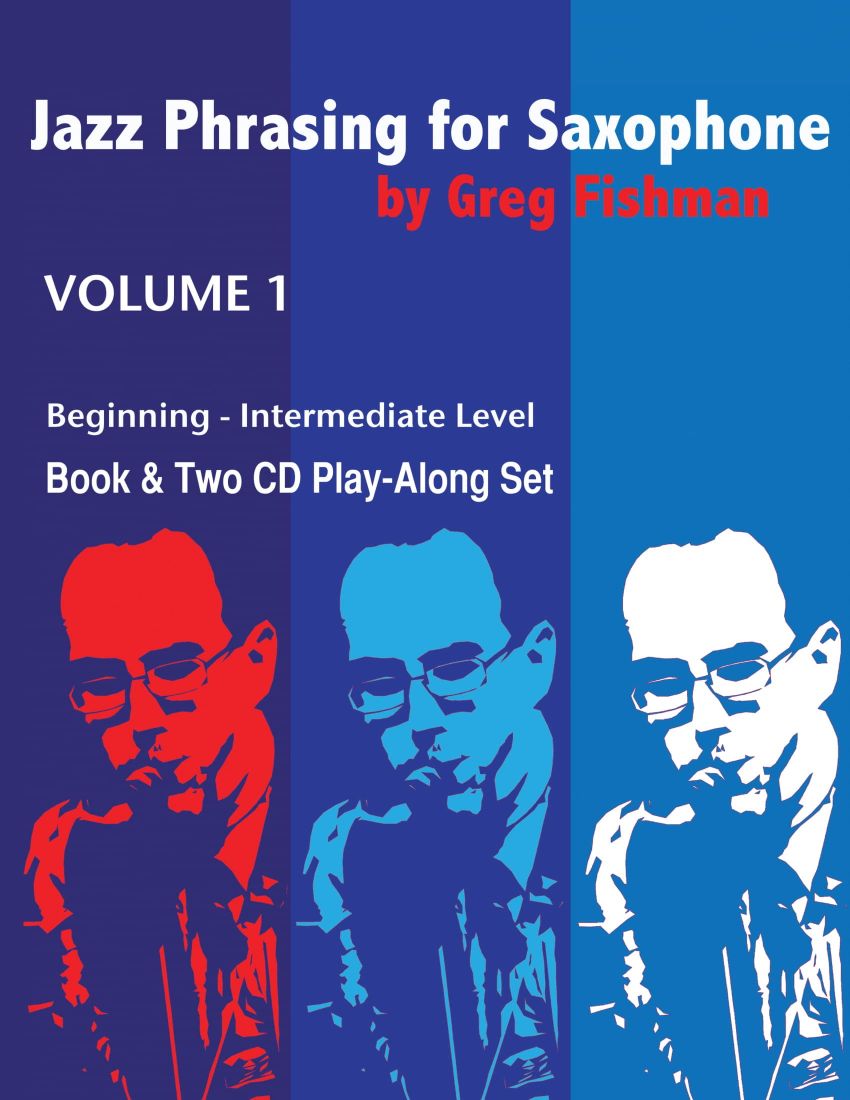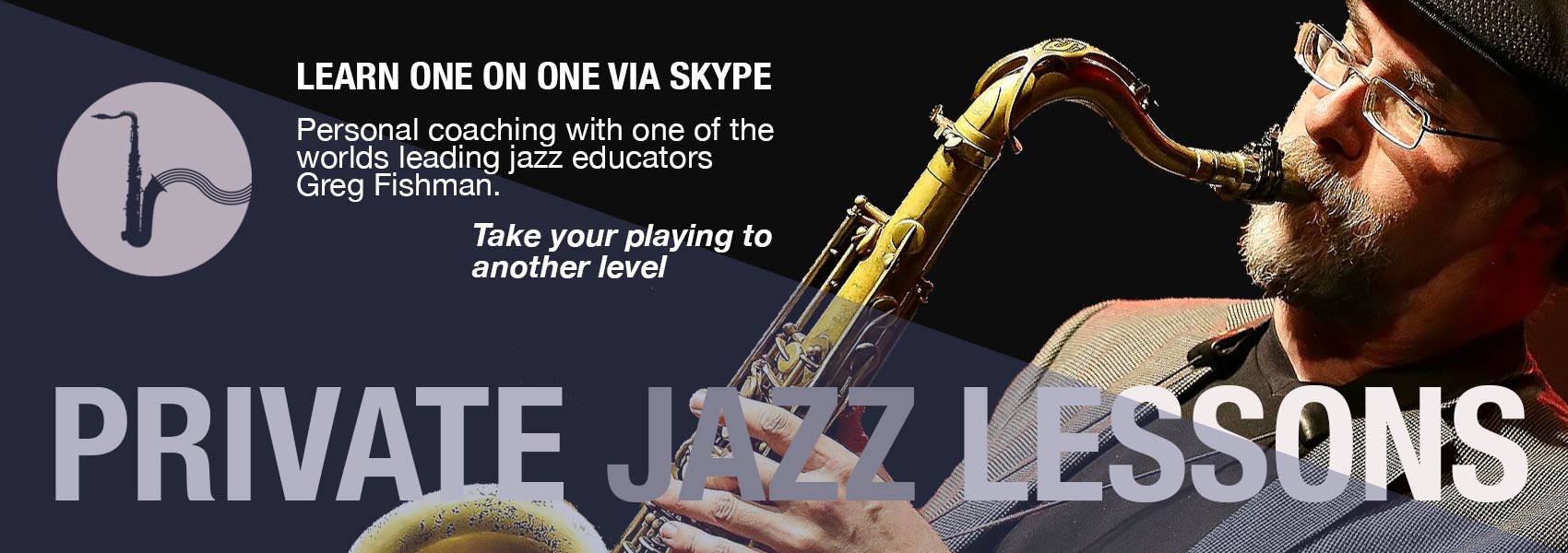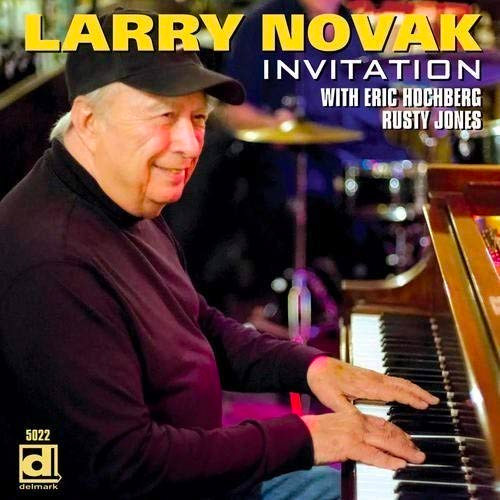Jazz Phrasing for Beginners
Reviewed by Raymond Davis
This book is written and produced by an extremely accomplished sax musician. I worked through some of his more advanced books (didn’t do that well with those) but the 10 songs and accompanying CD in this book are superb. There is a separate CD for Alto or Tenor Sax. The odd numbered tracks of the CD feature Greg and a great jazz group accompaniment. You hear him play relatively simple songs WITH great articulation and dynamics and musicality. You hear what the song should sound like with a real pro. The second track of the song (even numbers) is just the background group. You get to play Greg’s part and try to emulate what an accomplished sax player does. Just like playing with a great jazz group. It’s challenging and excellent ear and embouchure training. You strive to achieve sustained, musically pleasant long notes. It builds up your embouchure, vibrato, and forces you to get better at breath control. As I learned five years ago when I started the sax, it’s an easy instrument to play; it’s a hard instrument to play WELL.
I’m in my 50’s–I’m no kid. I played guitar in a professional rock band in my youth–so I have musical talent. I’ve been playing sax for five years now. I have 10-12 other duet books with CD’s which I have learned from and enjoy playing. This book is by far the best for the experience of learning how to judge and improve your sound, get a good feeling for jazz, and the simple enjoyment of playing along with a great jazz group. It’s the best $24.95 I have ever spent for a book that will improve my playing IMMENSELY! I used it for about 4 weeks now. Once I master all the nuances of the songs and the playing tips Greg provides in the beginning, I will be able to move on to his more advanced books with confidence.
Thank you Greg for finally putting together this “beginner’s” book. You will make me a much better musician. There is hope for my playing.
Jazz Phrasing for Beginners
Alto & Tenor Saxophone Edition
by Greg Fishman
Review by E.J. Svoboda
Greg Fishman, noted jazz educator and performer, has released his latest instructional book Jazz Phrasing for Beginners. This book addresses the needs of the novice jazz player. Fishman is well known for his tenor sax and flute work as a solo artist and with Paulinho Garcia in the duo Two for Brazil. He also regularly works with the talented pianist Judy Roberts in the studio and live. His playing has been called warm and soulful, evoking memories of his hero Stan Getz with his seemingly effortless melodic lines. Like Getz, he has an uncommon gift for moving between disparate styles including Brazilian, swing, traditional jazz, and bop.
The etudes in Jazz Phrasing for Beginners are appropriate for any student who has a couple of years on the horn and is just beginning to explore the world of jazz. The majority of the etudes in this book sit nicely in the middle range of the horn. The tempos are appropriate for the novice jazz player. The etude book also includes two CDs which feature recordings of Greg playing the etudes on alto and tenor saxophone as well as with a backing band.
Fishman’s previous jazz instruction books, Jazz Saxophone Etudes, Jazz Saxophone Etudes Volume 2, and Jazz Saxophone Duets, had etudes in them titled after well-known Chicago streets. In Jazz Phrasing for Beginners, Fishman continues that practice even though he now splits time between Arizona and Chicago. He still maintains a thriving jazz studio in the windy city.
In the first part of the book, Fishman gives some background on why he wrote the book and how it might be used by the student studying it. Particular attention should be paid to the brief discussion of voice-leading and sequences. Each etude introduces the beginning jazz player to an element of music that they are likely to encounter in the real world. Most importantly, the music feels like some of the repertoire that one would find commonly in a jazz/big band. All of which results in a very approachable set of etudes.
“Belden Avenue”, a tune with three sharps, has a series of interesting intervals to give the fingers a nice workout. “Quincy Street” shows an effective way to play altered figures of the same theme. This approach is used extensively in jazz charts. “Rockwell Street” has a minimal set of chord changes yet still shows what can be done to keep a line interesting over many bars of a single chord. “Franklin Street” is simply a great tune that again explores the concept of variation of a theme in a solo. I noticed that when played at a faster than indicated tempo this became a very challenging piece. On the whole, I found that Fishman does an excellent job of bringing into view a variety of jazz forms for the beginning student including blues, mid-tempo ballads, and bossa novas.
Like any book of etudes, there are many beneficial ways to use them in your practice routine. The most obvious way is to simply to play through an etude until it can be played at the written tempo without any errors. Once the etude is mastered, it may be interesting to play it at faster tempos to increase the level of difficulty. Some players may find it helpful to play along with Fishman’s recorded sax from the CD, while others may find it beneficial to listen to the etude as recorded before they master it. Another constructive use of the accompanying CDs is to play along with only the backing track and to create your own solos based on the chords played by the backing band. This approach is a form of ear training that allows the student to explore jazz improvisation without delving deeply into the world of chords. If possible, the beginner should record themselves playing along with the backing band in order to hear what is working for them within a solo and what could be improved. It might also be worthwhile to transcribe these newly created solos or to transcribe the solos played by Greg on the CDs. This practice will help a student to further improve their transcription skills.
While this book of etudes is geared toward the beginner, I believe that the advancing player can also benefit from spending some time working through the material presented. These players sometimes find it useful to slow things down. This could be to work specifically on improving one’s tone or to practice playing in slower tempos. On the bandstand, not all tunes go by at the breakneck tempos of hard bop but instead lay at a comfortable pace such as one would find while playing a ballad or a cool jazz chart. Jazz Phrasing for Beginners does a great job of avoiding the use of standard patterns and instead utilizes melodic lines that have a more organic or natural feel to them. Essentially, Greg Fishman has given the advancing player a road map out of the constant stream of predictable patterns.
Many times it is the little things that separate a book from its competitors. Greg Fishman has paid attention to the small items that many people may not notice such as quality and the feel of the paper used. Far too many times I am confronted with method books that are flimsy and that have notes which bleed through from the opposite page or that have covers that rip easily. This book feels like it would survive some serious transit time in a backpack which is the preferred means of transportation of this kind of material for the typical beginning jazz player. The second noticeable item is that the book contains two CDs as mentioned earlier. Fishman includes two CDs with this book, one for Eb instruments and one for Bb instruments. In the former case, Fishman plays alto and on the latter, he plays tenor. However, these etudes could easily be played on baritone, soprano, or any of the other more exotic members of the saxophone family.
Greg Fishman has created another great resource for saxophonists with another set of challenging and melodic etudes, but this time the beginning jazz player benefits from all the years of Greg’s experience. After the beginning player masters these etudes, they can begin working on the other wonderful books that Fishman has written, starting with the first volume of Jazz Saxophone Etudes. Jazz Phrasing for Beginners is a book that I will be recommending to beginning jazz players for years to come.



